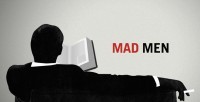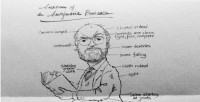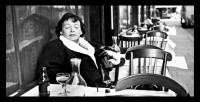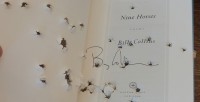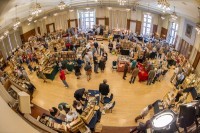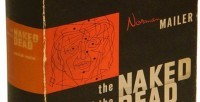Over eight years ago, Vagabond Books, located in Pasadena, CA, got a call from a woman named Ellen. She explained that she was the Propmaster for a new show, Mad Men, on AMC and asked if we could find contemporary books for them. For the past seven seasons, we have provided hundreds of vintage hardcover and softcover books for the show including: The Godfather, Slaughterhouse Five, Wall Street Jungle, Valley of the Dolls, Portnoy's Complaint, six Jewish Prayer books from 1969 for a funeral, Sally's school books, children's books, and Betty's Freud paperback for college. The producers required that all the books be historically correct, tied specifically to the year portrayed in the show, and in like-new condition. Every year we sold them many boxes of books published in the year they were filming. This arrangement led us on many fun and interesting adventures to locate books for them. For example, the opening shot for season six shows Don Draper reading a paperback copy of Dante's Inferno sitting on the beach in Hawaii. The first few immortal lines of this classic were read to the viewers in a voice-over that established the motif for the entire season. Unable to locate the exact copy required for this scene through the usual channels, we finally located the as-new 1969 paperback in a library bookstore in Atascadero, CA, only a couple of days before shooting began. Naturally the books we provided had to look new. Except for Nursery Friends from France. It was Betty's when she... [more Finding Books for Mad Men]
The ABAA has recently approved several new members, all of whom have successfully proven themselves to be, in the words of the ABAA Guarantee, "established, knowledgeable, and of excellent reputation." These new members were sponsored by existing members, and have undergone a rigorous screening process. We welcome the newest members of the ABAA. James M. W. Borg, Ph.D., Borg Antiquarian, Lake Forest, IL "As a RELIC from the 70's, I've returned in my 70's to a more challenging antiquarian bookselling world. A doubter of Christian NON-Science at 6, I converted to Huxleyan "Agnosticism" at 13, though I've retained a profound interest in the History of Religions. At the U of Michigan, I studied English & history. Served as an Army officer during Vietnam; then earned my Ph.D. from Northwestern focusing on 19th c. English lit (disst. on E.B. Browning). Married 50 years to Sharon. We have 3 semi-adult offspring & 4 grandchildren (+ 2 cats). Stock (rare & fine books, mss, prints, memorabilia, library art) tends toward High Spots from the 17th-20th century (esp., Dickens & Darwin) plus Americana (Founders, Rev. & Civil War; presidents)." Mark Anderson, Anderson Butler Rare Books, Seattle, WA "I started in the trade working in a used book shop in Omaha in 1999; after moving to Seattle in 2003, I began to interact with many of the Seattle book dealers at fairs, book shops and breakfasts. Several of these book dealers were ABAA members, and the wisdom and knowledge received from them and... [more New Members: May 2015]
Throughout history, writers have been known to cause a stir. The Marquis de Sade was incarcerated in an insane asylum for his erotic tales. Oscar Wilde self-exiled himself to Paris for the unimaginable treatment he received for the “crime” of homosexuality. Harriet Beecher Stowe caused a flurry of activity around the anti-slavery act in the United States. Vladimir Nabokov's Lolita was banned in many different countries, including France (you know it's controversial when even the French consider it obscene…). In modern days we have parents and schools banning books by authors like Judy Blume and Laurie Halse Anderson because they deal with sex and coming-of-age experiences in young-adult fiction. We can only imagine the hell-fire that would begin to burn should any school library choose to keep a holding of The Lover or The Ravishing of Lol Stein on hand! Marguerite Duras, the French novelist, essayist, playwright and film director, could certainly be considered controversial in both work (like the Marquis) and life (like Wilde). Despite the often explicit and controversial themes and plots in her novels, many of which were drawn from her real-life experiences, Duras has been a beloved figure in the field of “serious literature” (a genre I just made up, you'll be pleased to know) for decades. Marguerite as a young girl in Indochina, pictured here with her brothers Pierre and Paulo and a friend. Marguerite Donnadieu (pen name Duras, taken after the French town where h... [more Marguerite Duras & the Minimal Novel]
Miegan Gordon of Asheville, NC's Captain's Bookshelf got a surprise last month when she opened the store. A copy of Billy Collins' poetry collection Nine Horses (a signed first edition, no less) was looking a little worse for wear. It was full of holes punched from front to back, and the author photo had been altered to make Collins look like a silent movie villain, complete with curling mustaches, goatee and an evil-looking eyebrows. At first, the store staff wondered if somebody had hacked at it with an ice pick. But, after local police stopped by to compile a report, the officers recognized what had actually happened to the book: it had been blasted with a shotgun, probably a .410, they remarked. The damage is most apparent from the spine view. Asheville is where I make my home, so I popped over to the Captain's Bookshelf to view this now-unique collectible -- with the words of Collins' poem “Building with its Face Blown Off” rattling around in my head: “How suddenly the private is revealed in a bombed-out city.” Does blasting a book apart make it easier to access the poetry inside? -- and heard the full story from owner Chan Gordon. From the code number inside the book, Gordon was able to determine that he bought the book about two years ago. What happened next is a mystery. Gordon feels a signed first edition of Billy Collins would not have sat on the shelf unsold for two years, so presumably the book was bought (or prehaps stolen) within that time, and recently ... [more Extreme Poetry Criticism]
This item is still missing as of 5/31/2019. Orpheus Books in Redmond, Washington reports: On April 22, 2015, the following title went missing from our customer's doorstep in Roxbury, MA: Steve Holl. Steven Holl: Architecture Spoken. The book was inscribed and dated by architect Steven Holl on the title page: For Chuck & Linda, S. Holl 7/23/07. The book is a first edition in very fine condition with a clear archival mylar cover. Anyone offered this title should contact: Barbara Wight / Don Stutheit Orpheus Books 10425 170th Ave. NE. Redmond, WA 98052-2740 425-556-9376 [more Missing: Inscribed Steven Holl]
Among the many reasons we'll be sorry to see the end of Mad Men is the bravura way the writers have woven literary references into the show. Characters have been seen reading books that were popular at the time as well as obscure volumes that explored themes they would have found very meaningful at the time. We went back through the DVD box-sets, and noted the major titles featured and a few of the more interesting minor ones. Atlas Shrugged by Ayn Rand Way back in season one, Rand's objectivism was established as an influence on Don's character: driven, selfish, and ambitious. The book was recommended to Don by Bert Cooper, and from Don's confident and egotistical pitch to a client in episode eight, he appears to have taken it to heart. The Sound and the Fury by William Faulkner After bedding Joy in season two, Don sees her reading The Sound and the Fury. He asks if it's good, and she answers that she enjoyed their romp, but the book is only OK. The allusion to this chronicle of a dysfunctional old Southern family dealing with financial and social ruin is obvious. The Agony and the Ecstacy by Irving Stone Used as a rather heavy religious metaphor to underline how Peggy is changing her life in the second season. The History of the Decline and Fall of the Roman Empire by Edward Gibbon While Betty's father lives with the Drapers after his dementia becomes acute, Sally reads this from the Decline and Fall every night. The repeated allegory is a little heavy handed. The Spy Who C... [more The Books of Mad Men]
Fight of the Century: Auction Houses vs. Dealers Editor's note: Greg Gibson of Ten Pound Island Book Co., a specialist in “wet books” (maritime books, manuscripts, ephemera, sea charts, etc.,) has for the past five years authored a weekly blog chronicling his life in the rare book trade. Because he is smart, observant, witty and outspoken, and because he is a gifted writer (the author of several books) Bookman's Log makes for great reading on many topics of interest to antiquarians – market trends, the effect of the internet, reviews of book and paper shows, and sundry anecdotes about fellow dealers and collectors. In the past, Gibson has made passing comments on the undeclared war between dealers and auction houses, but those were mere shots across the bow compared to the anti-auction cannonade of his last two contributions. Although many dealers and auction houses work together on all sorts of levels (referrals, consigning, bidding, cataloging) the two groups are joined in basic competition for the material being offered and for the clients who might buy that material. When the stakes are high, this competition can become fierce. Book dealers and auction houses each offer certain advantages over the other. A dealer can engage in a relationship with a collector, get to know what that collector needs, scout up material and offer it directly, advise the collector, and so forth. This increases the level of trust between dealer and client, and friendships often result. An ... [more Auction Houses vs. Dealers]
Some brief history In 1824, land speculators John Allen and Elisha Rumsey founded Annarbour, Michigan. (They named the town after their wives, Ann Allen and Mary Ann Rumsey; history is silent on whether Mary angled for top billing.) In 1837, the University of Michigan was moved to Ann Arbor. And then in 1965 the proto-punk pioneer Iggy Pop graduated from Ann Arbor's Pioneer High School. Today, Ann Arbor still has its world-class university and punches above its weight when it comes to book shops and restaurants—it's a pretty good small city, even if the local Arbor Wiki project notes “here is no Iggy Pop museum.” But for bibliophiles of all stripes looking for something to do—even those at loose ends and nursing a grudge after a disappointed pilgrimage to the yet-unbuilt shrine to the genius of Jim Osterberg—the 37th Annual ANN ARBOR ANTIQUARIAN BOOK FAIR celebrates its 39th anniversary in 2015, when it will be held from 11am to 5 pm on Sunday, May 17, 2015 at the Michigan Union on the campus of the University of Michigan. The $5 admission to the fair benefits the William L. Clements Library at the University of Michigan, one of the best Americana libraries going. Ann Arbor itself—a suitably arboreal college town in the Midwestern mold, with a strong local food scene and an anachronistic wide range of open, street-level antiquarian, used, and new bookstores—is always well worth a visit in the spring; should the prospect of visiting one of the longest-running ant... [more Ann Arbor Antiquarian Book Fair]
UPDATE (5/13): RECOVERED Adam Davis of Division Leap in Portland, Oregon reports: "Our car was stolen today from outside the shop. There were a couple hundred 8vo sized zines in the back, and two binders with ephemera. We don't have a list of the contents yet- but I would think this many zines hitting the market would be a bit of an anomaly. . . . There was a complete run of the zine Dishwasher, but aside from that I don't have an inventory of that material. "Some of the material will have my pencilled price at upper right hand corner of first blank, with a 5 Digit number at the lower tip of same Page beginning with a 1 or a 2. Local bookstores have been alerted." Please keep your eyes/ears/email reading open for queries about a quantity of this sort of material, esp. if you are in the PDX area. Please contact ABAA Security chair Garrett Scott,
A few select items offered by ABAA members for the week of May 4th 2015, also known as (Intergalactic) Star Wars Day... Star Wars: From The Adventures Of Luke Skywalker by George Lucas Ballantine, 1976. First Edition. Mass Market Paperback (Offered by Yesterday's Muse, Inc.) A long time ago, in a childhood far, far away, many of us read this novelization of a new movie called Star Wars. Although credited to George Lucas, the book was actually ghostwritten by science-fiction author Alan Dean Foster. The book was released six months before the film -- in order to be on shelves for Christmas 1976 -- so several plot points differ from the final movie, which was still being edited when Foster received his synopsis. The tsunami of Star Wars merchandise that folowed the film's unexpected success has obscured the fact that it all started with this modest mass-market paperback. As a child, I read and re-read my copy until it disintegrated, and Star Wars toys became the first thing I collected with passion. If only I'd been a more careful reader, my copy might be worth something today. Search for other copies of Star Wars: From the Adventures of Luke Skywalker... The Naked and the Dead by Norman Mailer New York: Rinehart and Company. (1948). First edition. (Offered by Quill & Brush) A presentation copy of Norman Mailer's acclaimed debut novel, which was included in the Modern Library's list of the 100 best novels of the 20th century. Inscribed to Adeline Lubell-Naiman, an editor who wa... [more Featured Items]


